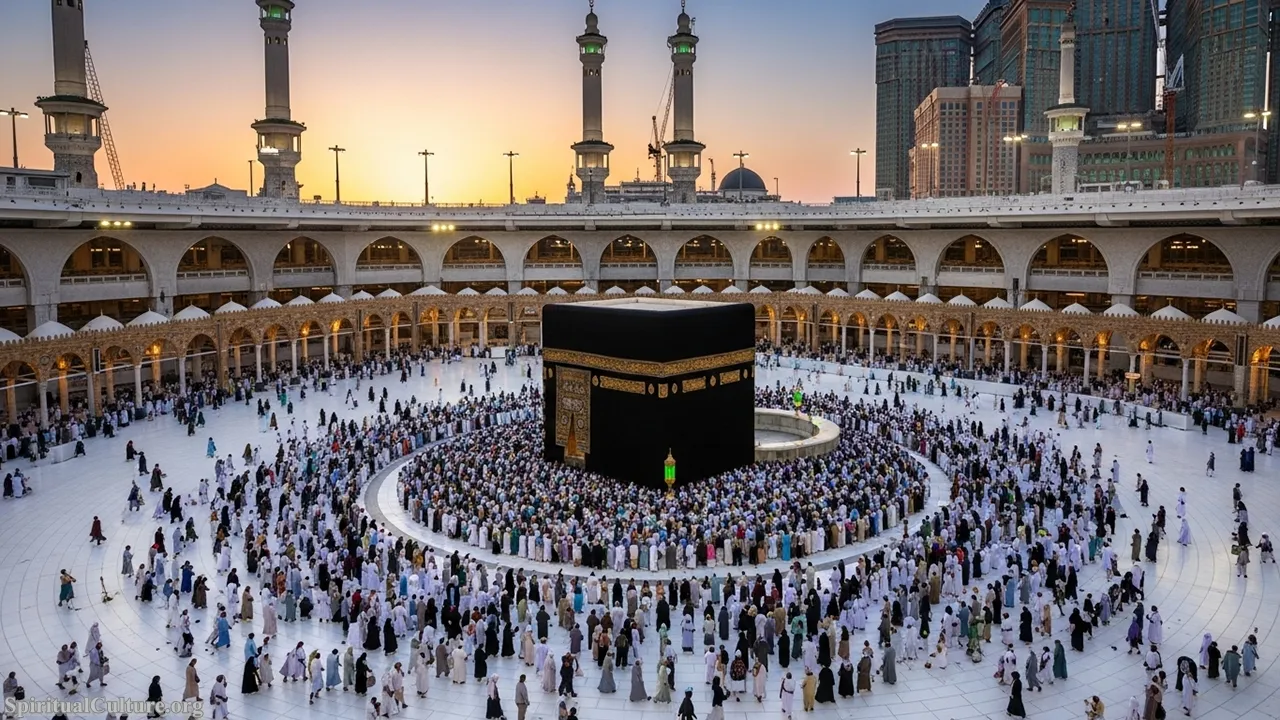The cultural landscape of Japan, a nation defined by its dynamic synthesis of ancient ways and hyper-modemity, is one of the world’s richest studies in spiritual continuity and aesthetic refinement. For centuries, its traditions—the “Ways” or dō—have served not merely as customs but as profound philosophical frameworks for living, reflecting an intimate reverence for nature (Kami in Shinto), an acceptance of impermanence (wabi-sabi derived from Buddhism), and a commitment to meticulous craftsmanship (shokunin spirit). As of the Current Time of Writing, these traditions remain the bedrock of Japanese identity, influencing everything from daily etiquette to its world-renowned arts.
In a society where up to 80% of the population practices Shinto, and nearly half follows Buddhism, the boundaries between the secular and the sacred are often blurred. Many citizens who identify as non-religious still participate in traditional ceremonies—visiting Shinto shrines for New Year’s (Hatsumōde) and utilizing Buddhist rites for funerals—treating them as cultural practices integral to their lifecycle.
This ranking celebrates the ten most impactful cultural traditions, assessing their historical longevity, depth of spiritual meaning, and ongoing influence on the collective soul of Japan, providing an authoritative guide for Spiritual Culture readers.
Table of the Top 10 Most Important Cultural Traditions in Japan
| Rank | Tradition | Type/Discipline | Spiritual Basis | Cultural Influence (Approx.) |
|---|---|---|---|---|
| 1 | Shinto & Buddhist Rites (Shinbutsu-shūgō) | Religious/Lifecycle Rites | Kami worship, Ancestor Veneration | Continuous for ~1,400+ years |
| 2 | Tea Ceremony (Chadō) | Art/Philosophy/Etiquette | Zen Buddhism (Wabi/Sabi) | Continuous for ~500+ years |
| 3 | Matsuri (Traditional Festivals) | Folk Culture/Community Rites | Appeasing Kami, Seasonal Rites | Continuous for ~1,000+ years |
| 4 | Bushi-dō (The Way of the Warrior) | Moral Code/Ethos | Zen, Confucianism, Shinto | Continuous for ~800+ years |
| 5 | Hanami (Cherry Blossom Viewing) | Seasonal Custom/Aesthetic | Mono no aware (The pathos of things) | Continuous for ~1,200+ years |
| 6 | Washoku (Traditional Japanese Cuisine) | Dietary Culture/Craftsmanship | Respect for ingredients, UNESCO Status (2013) | Continuous for ~400+ years |
| 7 | Calligraphy (Shodō) | Art/Discipline | Zen, Meditation, Focus | Continuous for ~1,500+ years |
| 8 | Ikebana (Flower Arranging) | Art/Discipline | Buddhist offerings, Harmony with Nature | Continuous for ~600+ years |
| 9 | Kimono & Traditional Dress | Fashion/Etiquette | Social status, Seasonal transition, Rites of Passage | Continuous for ~1,000+ years |
| 10 | The Art of Gardens (Nihon Teien) | Aesthetic/Environmental Design | Zen/Pure Land Buddhism, Shinto (Yorishiro) | Continuous for ~800+ years |
Top 10. The Art of Gardens (Nihon Teien)
The traditional Japanese garden, or Nihon Teien, is far more than a landscape; it is a meticulously crafted microcosm designed to represent nature’s grandeur, offering a physical space for contemplation. Styles like the Zen rock garden (karesansui) or the Pure Land garden were developed as symbolic expressions of spiritual ideals, meant to transport the viewer to an inner reality or a celestial paradise. The garden’s enduring importance lies in its ability to condense the vastness of the natural world—mountains, islands, and oceans—into a human-scale work of art.
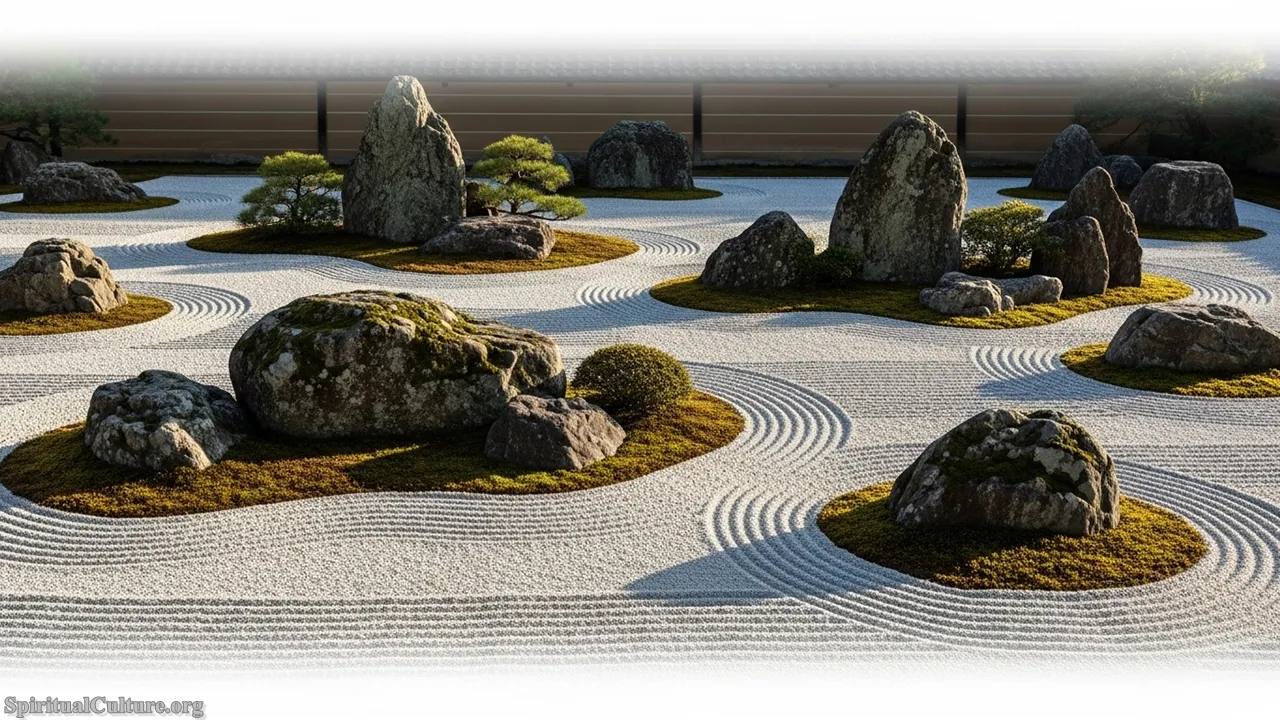
For centuries, the garden has served a pivotal role in Japanese spiritual life, acting as a contemplative arena that mirrors the search for enlightenment. By arranging stones, moss, raked gravel, and carefully pruned trees, the gardener is engaged in an act of artistic meditation, striving for a sense of harmony (wa) and cultivated simplicity (wabi). This practice elevates landscaping to a spiritual discipline, inviting observers to pause and find the eternal within the transient details of the arrangement.
The continued preservation of these gardens, from the ancient estates of Kyoto to contemporary urban spaces, serves as a powerful reminder of humanity’s deep-seated connection to the land and the sacredness of the natural world. They teach the moral lesson of balance: that true beauty is found not in excess, but in restraint, natural composition, and the profound beauty of age and weathering, embodying the ethos of sabi.
Cultural/Spiritual Highlights
- Often feature a yorishiro, an object or area capable of attracting kami (Shinto deities).
- Karesansui (Zen gardens) utilize raked gravel to symbolize water, encouraging silent meditation.
- The placement of every rock and tree reflects centuries of Buddhist and Shinto aesthetic principles.
- Represents the highest expression of the wabi-sabi aesthetic in physical form.
Top 9. Kimono & Traditional Dress
The Kimono, meaning literally “thing to wear,” is perhaps the most universally recognized symbol of Japan, yet its importance transcends fashion; it is a profound cultural marker of social status, season, and rite of passage. Its flowing, straight lines and meticulous construction reflect a deep-rooted respect for craftsmanship and a design philosophy that flatters all body types. Worn today primarily for formal ceremonies like weddings, graduations, and Matsuri, the Kimono links the wearer directly to a thousand years of heritage.

The spiritual impact of the Kimono is tied to its use in formal religious and ceremonial contexts, turning the act of dressing into a ritual. Its patterns, which often depict nature scenes like flowing water, pine trees, or specific seasonal flowers, carry symbolic meaning, allowing the wearer to feel in harmony with the cosmos and the changing year. By donning a Kimono, one consciously participates in a time-honored tradition, embodying the concepts of grace, modesty, and respectful formality.
The survival of the Kimono industry, despite the prevalence of Western clothing, stands as a testament to the nation’s commitment to preserving its ancestral identity and the value of handcrafted artistry. It teaches that clothing can be a form of reverence, where the beauty and meaning of an outfit are derived not from current trends, but from the deep-seated cultural narratives woven into its fabric.
Cultural/Spiritual Highlights
- Fabrics and patterns are strictly seasonal, reflecting the Shinto emphasis on nature and transition.
- Worn during major life ceremonies like Shichi-Go-San (7-5-3 festival) and weddings, acting as a ritual uniform.
- The way the fabric is wrapped and tied (obi) is a complex, ritualistic discipline taught over years.
- Signifies a return to a state of formal, cultural purity during sacred times.
Top 8. Ikebana (Flower Arranging)
Ikebana, the “living flowers,” transforms simple floral arrangement into a disciplined art form that seeks to harmonize humanity with nature. Unlike Western floral displays, Ikebana focuses not on the mass of blossoms but on the balance of negative space, line, and color, emphasizing three main elements: Heaven (Ten), Earth (Chi), and Human (Jin). It is a meditative practice that demands concentration, patience, and a deep appreciation for the beauty of a single stem or leaf.
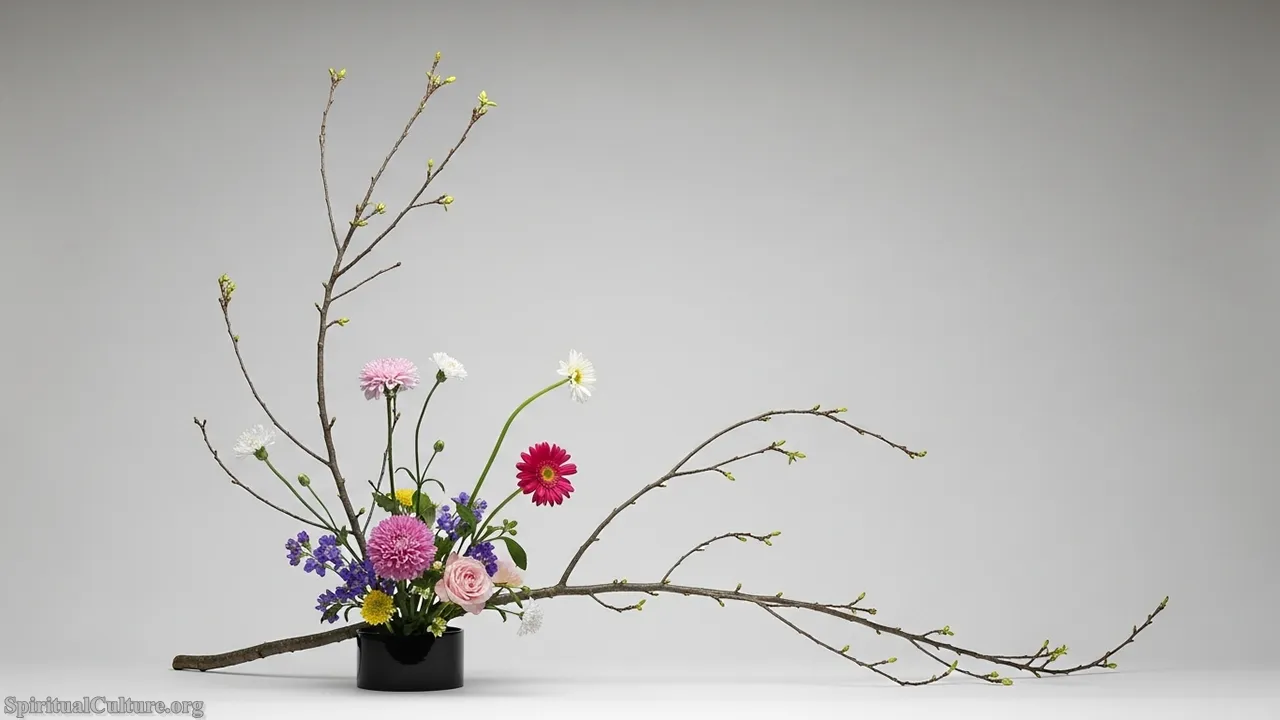
Its spiritual foundation is rooted in the Buddhist practice of offering flowers (kuge) at altars, which evolved into the sophisticated art of the Ikenobō school starting in the 15th century. Ikebana instills a profound spiritual perspective: it forces the practitioner to confront the transient nature of life, as the arrangement is inherently temporary. This acceptance of change and decay, known as shogyō mujō, is a core Buddhist lesson that finds elegant expression in the composition.
Practicing Ikebana today is an act of preserving a thousand-year-old aesthetic and philosophical tradition in an increasingly fast-paced world. It offers a vital moral lesson in mindfulness and the search for beauty in simplicity, reminding us that even the shortest, most fragile existence—like a cut flower—possesses an inherent, universal dignity.
Cultural/Spiritual Highlights
- Originated from the Buddhist custom of arranging flowers as offerings to the dead.
- The three main stems (Heaven, Earth, Human) represent the fundamental harmony of the cosmos.
- The art emphasizes line and space, drawing on Zen ideals of minimalism and purity.
- Practitioners often enter a meditative state (mushin) while composing the arrangement.
Top 7. Calligraphy (Shodō)
Shodō, or “the way of writing,” elevates simple handwriting to an expressive spiritual discipline, where the mind, brush, ink, and paper must work in perfect, instantaneous harmony. It is the art of rendering the profound beauty of kanji characters with a single, unhesitating stroke. The finished work is not merely a statement of words but a direct, unedited representation of the artist’s spiritual and mental state at the moment of creation.
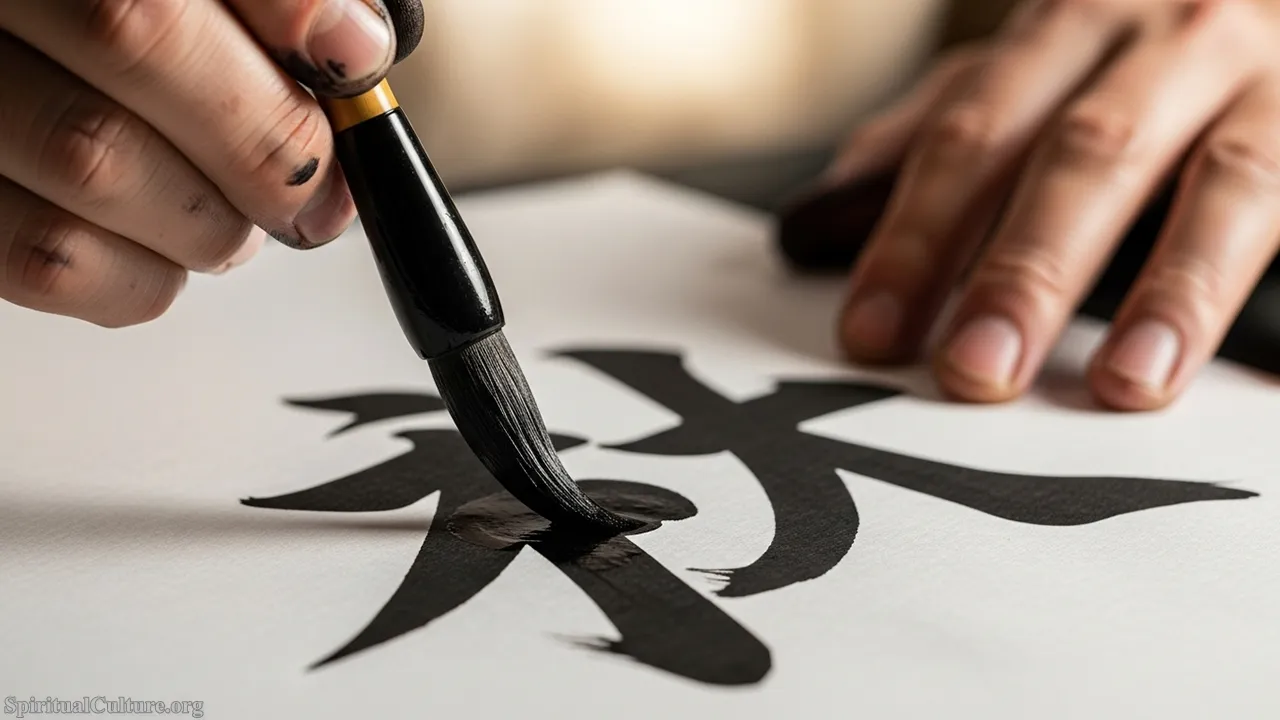
The spiritual impact of Shodō is profound, closely aligned with Zen Buddhist practice. It demands intense concentration and a state of non-mind (mushin), as every stroke is irrevocable. The discipline is a form of active meditation, training the practitioner to achieve perfect balance and focus, making it a “Way” of self-cultivation. The act of grinding the ink and preparing the paper also becomes a ritualistic process, settling the spirit before the creative burst.
Though much modem communication is digital, the tradition of Shodō remains essential for formal documents, temples, and artistic expression, serving as a pillar of Japanese aesthetic identity. It teaches that the journey is more important than the destination, and that true perfection lies not in flawless execution, but in the authentic, moment-to-moment expression of the human spirit.
Cultural/Spiritual Highlights
- The practice is considered zazen (seated meditation) in motion.
- The characters often represent core philosophical concepts like Zen, Wa (Harmony), or Kū (Void).
- The single, unedited stroke reflects the Buddhist concept of ichigo ichie (one time, one meeting).
- The implements (brush, ink stone, paper) are treated with ritualistic respect.
Top 6. Washoku (Traditional Japanese Cuisine)
Washoku, which translates to “harmony of food,” is far more than a style of cooking; it is a social practice based on an essential respect for nature, careful preparation, and the seasonal cycle. Recognized by UNESCO in 2013 as an Intangible Cultural Heritage of Humanity, Washoku is defined by its use of fresh, local ingredients, its balance of five colors and five flavors, and the meticulous presentation that turns a meal into a form of art.
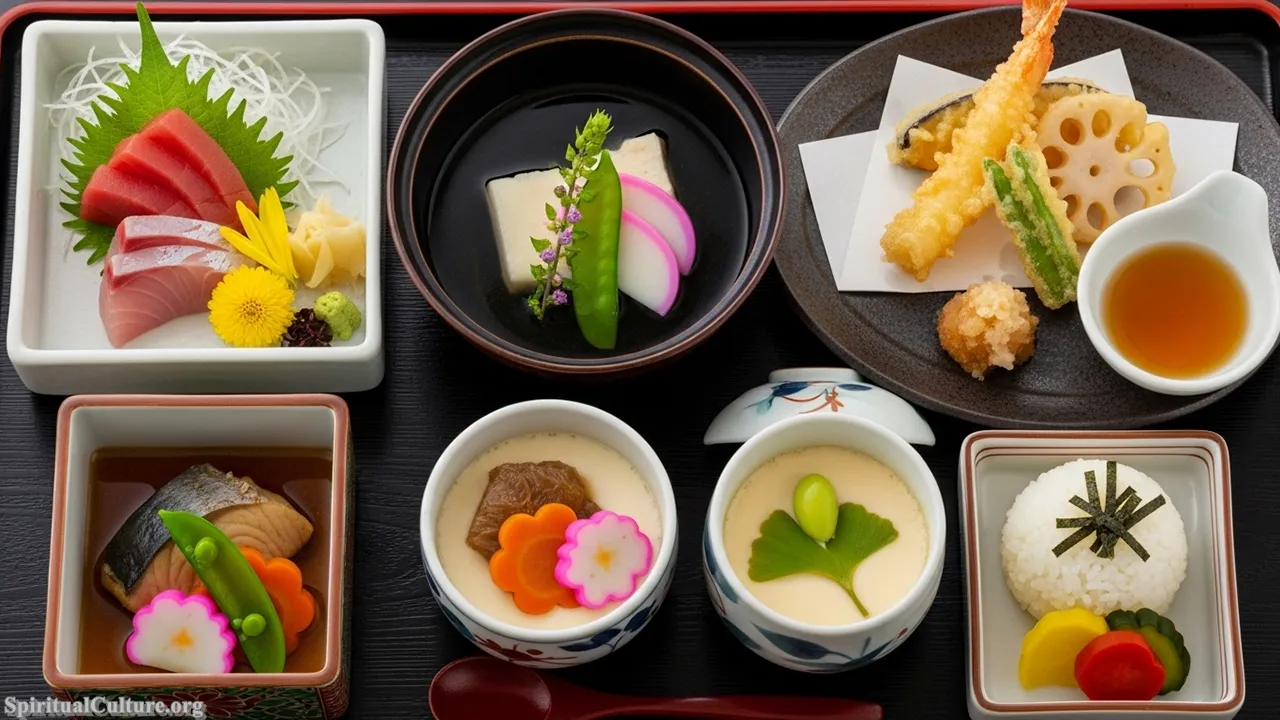
The spiritual core of Washoku is Mottainai, a profound sense of regret over waste, and an appreciation for the intrinsic value of all resources. It draws heavily on Zen Buddhist principles, particularly the idea that food is a gift from nature to be consumed mindfully and gratefully. This tradition elevates the chef (shokunin) from a cook to a dedicated artist, whose every cut and arrangement is an act of reverence for the ingredient and the natural ecosystem from which it came.
In the face of globalization, the continued practice and celebration of Washoku ensures the preservation of a uniquely Japanese perspective on sustenance, health, and environmental harmony. It teaches a moral lesson in gratitude: to eat is to humbly receive a blessing from the natural world, a daily ritual that binds the individual to their environment and community.
Cultural/Spiritual Highlights
- UNESCO Intangible Cultural Heritage status since 2013.
- Built on the principle of the “five colors” and “five flavors” for aesthetic and dietary balance.
- Reflects the Shinto reverence for the bounty of the land and the sea.
- The careful presentation is a spiritual act of respect for the diner and the ingredients.
Top 5. Hanami (Cherry Blossom Viewing)
Hanami, the annual custom of viewing the fleeting beauty of the cherry blossoms (sakura), is one of Japan’s most important and universally practiced cultural traditions. Every spring, the nation pauses to picnic and celebrate beneath the blossoms, a tradition that transforms a simple natural event into a communal, philosophical reflection on life’s deepest truths. The custom is deeply ingrained, transcending social class and region.
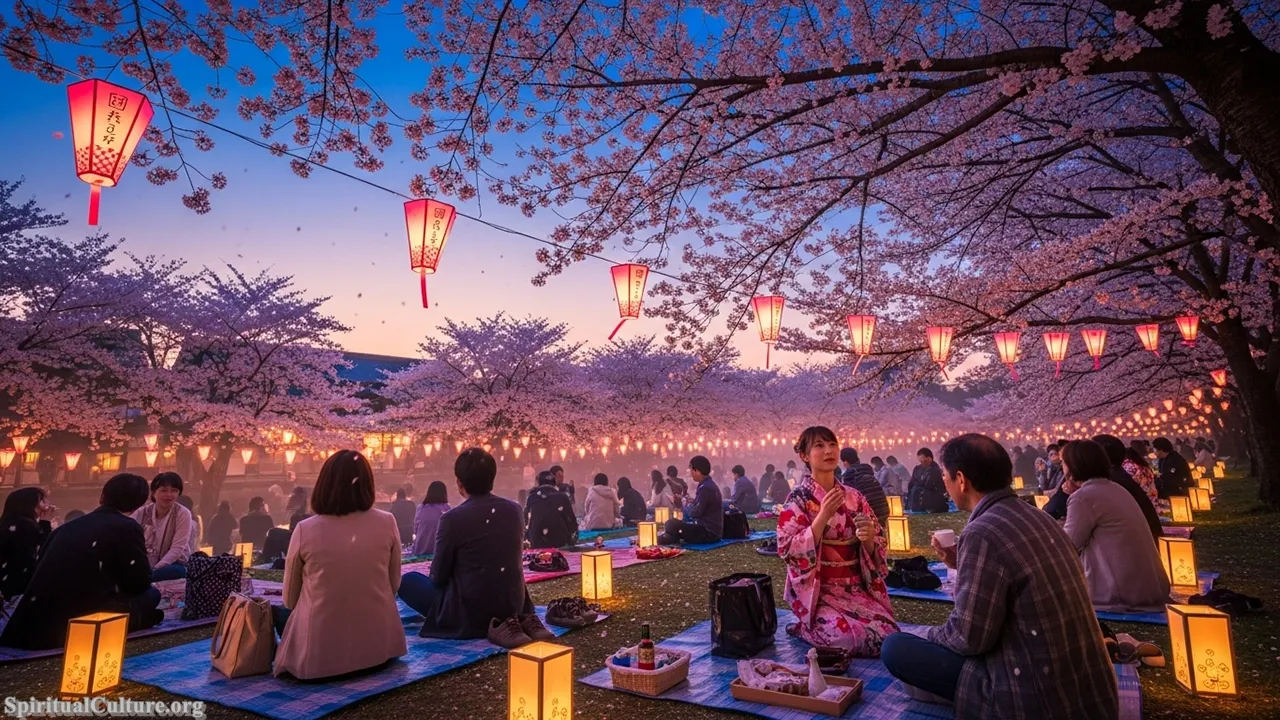
The spiritual power of Hanami lies entirely in the sakura‘s short lifespan. The blossoms bloom spectacularly but quickly fall, embodying the Buddhist concept of mono no aware—the pathos of things, or a gentle sadness at the transient nature of beauty and life. Observing the fleeting spectacle is a national, annual exercise in accepting impermanence, urging people to appreciate the present moment and reflect on their own mortality.
The tradition’s longevity, stretching back over a thousand years, confirms its profound resonance with the Japanese psyche. Hanami teaches the moral lesson that ultimate beauty is inherently fragile and temporary, encouraging a deep humanistic connection where joy and melancholy mingle, making life all the more precious for its brevity.
Cultural/Spiritual Highlights
- Embodies mono no aware, the poignant appreciation of the transient beauty of life.
- Has roots in Shinto, where farmers would pray to the kami in the trees for a good harvest.
- The ritualistic picnics transform a natural spot into a temporary, communal sacred space.
- The rapid, beautiful fall symbolizes the ideal, honorable death in the Bushi-dō code.
Top 4. Bushi-dō (The Way of the Warrior)
Bushi-dō, or “the Way of the Warrior,” is the unwritten code of moral principles that guided the samurai. While the samurai class itself was abolished in the late 19th century, its core tenets—integrity, respect, courage, honor, benevolence, loyalty, and self-control—remain a powerful, ubiquitous ethical force in contemporary Japanese culture. It is the philosophical blueprint for personal and professional conduct across the nation.
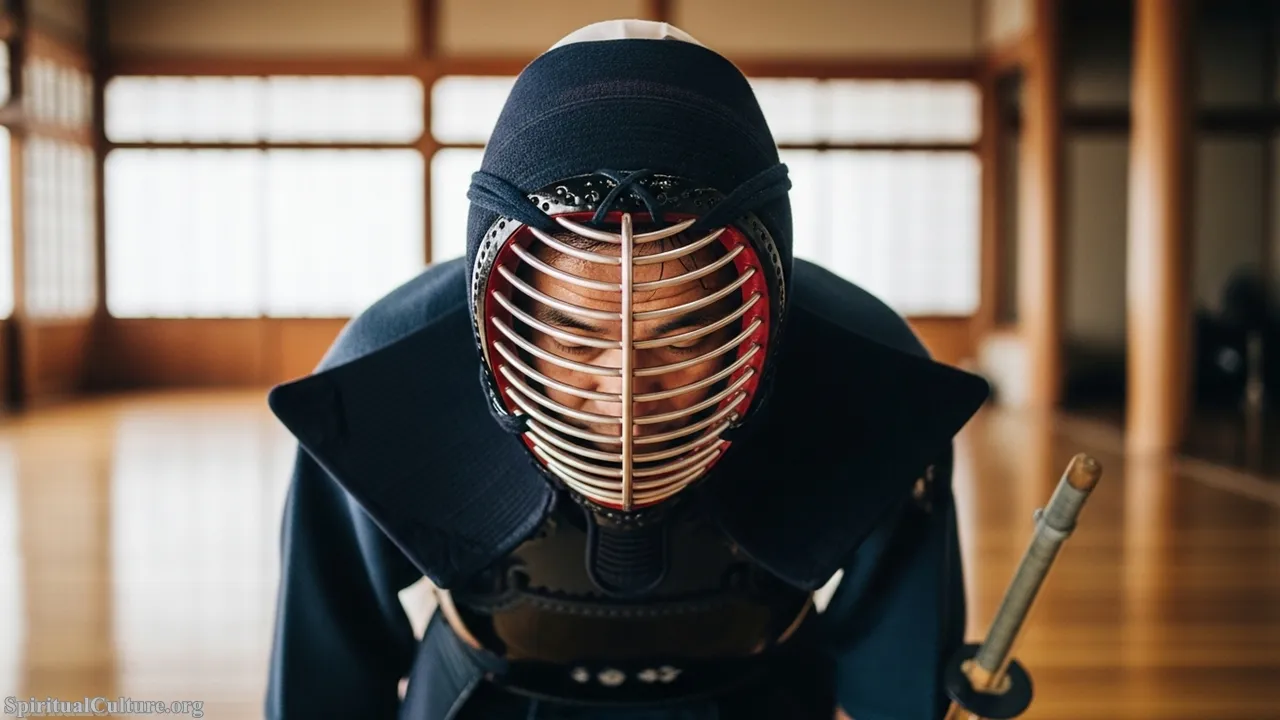
The spiritual influence of Bushi-dō is rooted in the syncretism of Shinto, Confucianism, and particularly Zen Buddhism. Zen provided the discipline necessary for the warrior to confront death with equanimity, cultivating a fearless, intuitive mind through meditation and martial arts training. The code demands absolute sincerity and ethical rectitude, shaping the spiritual character of leaders and the moral expectations of all citizens.
Despite its association with the military past, Bushi-dō’s enduring legacy is its emphasis on character and self-mastery. Its preservation today, seen in modem corporate ethos and martial arts (kendō, kyūdō), offers a moral lesson that true strength is not merely physical, but is found in unwavering adherence to a principled and honorable life, prioritizing duty above self.
Cultural/Spiritual Highlights
- Integrates Zen concepts of mushin (no mind) to achieve spontaneous action.
- Emphasizes loyalty (chūgi) as a spiritual bond surpassing individual desires.
- The principle of seigi (justice/rectitude) demands ethical conduct even when inconvenient.
- The meditative and spiritual training of many Budo (martial ways) derives directly from this code.
Top 3. Matsuri (Traditional Festivals)
Matsuri, the traditional Shinto and Buddhist festivals, are the pulsating heart of Japan’s spiritual community life. Occurring year-round, these regional and national celebrations—such as Gion Matsuri, Nebuta, and Obon—are loud, vibrant, and essential public rituals that temporarily shatter the nation’s usual reserve. They involve grand processions, ornate floats (Dashi), and, most importantly, the parading of sacred palanquins (Mikoshi) to carry the Kami.

The spiritual importance of Matsuri is foundational, acting as the primary means by which communities interact with their deities and ancestors. The festivals are rooted in Shinto’s desire to placate or celebrate the Kami, ensuring good harvests, prosperity, and protection from disaster. The collective energy generated during a Matsuri is a powerful spiritual cleansing, reaffirming the shared history and identity of the local Ujiko (parishioners) and maintaining the cosmic order.
As urbanization and depopulation challenge small towns, the fierce commitment to organizing and passing down Matsuri traditions highlights their incredible cultural importance for social cohesion. They teach a moral lesson in community responsibility and continuity, demonstrating that the sacred is not confined to a temple or shrine, but lives most powerfully in the shared, ecstatic experience of the collective.
Cultural/Spiritual Highlights
- UNESCO-recognized elements include “Furyu-odori” and “Yama, Hoko, Yatai, float festivals” (2016, 2022).
- The central ritual is parading the Mikoshi, a portable shrine housing the local Kami.
- Obon is a nationwide Buddhist tradition for honoring and comforting ancestral spirits.
- The communal effort and participation reinforce the Shinto connection between people, nature, and Kami.
Top 2. Tea Ceremony (Chadō)
Chadō, “the Way of Tea,” is a choreographic, highly formalized ritual that embodies four core Zen-inspired principles: Harmony (Wa), Respect (Kei), Purity (Sei), and Tranquility (Jaku). Developed into an aesthetic philosophy by figures like Sen no Rikyū in the 16th century, the Tea Ceremony is a secular rite that seeks to achieve spiritual perfection through the most mundane of actions—serving and receiving a bowl of tea. The immense cultural value lies in its discipline, its aesthetic of austerity, and its philosophical depth.
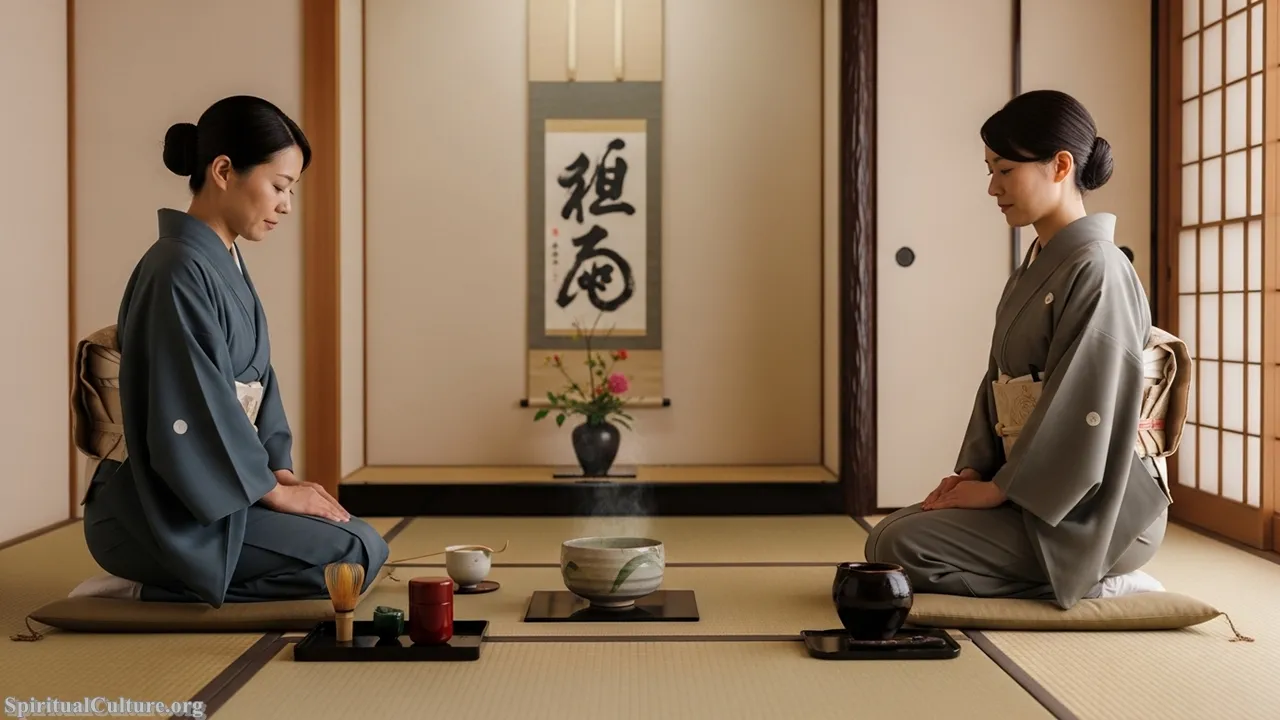
The ceremony’s spiritual impact is directly linked to Zen Buddhism. Every movement, every utensil, and the simple environment of the tearoom (chashitsu) is designed to strip away the distractions of the outside world, focusing the participants on the singular, irreplaceable moment of shared experience—***Ichigo Ichie*** (one time, one meeting). It is a profound lesson in humility, as host and guest are treated as equals, and in simplicity, embracing the raw, unpolished beauty of wabi-sabi.
The continued study and transmission of Chadō today ensure the preservation of a uniquely Japanese path to mindfulness and refined conduct. It provides a timeless moral lesson: that spiritual awakening is possible not through grand acts, but through the deliberate, respectful execution of the smallest details in everyday life.
Cultural/Spiritual Highlights
- Based on the four Zen principles: Wa (Harmony), Kei (Respect), Sei (Purity), and Jaku (Tranquility).
- The ceremony’s philosophy is the quintessential expression of the wabi-sabi aesthetic.
- Emphasizes the concept of Ichigo Ichie: cherishing every moment as unrepeatable.
- The low entrance to the tearoom (nijiriguchi) forces everyone—regardless of status—to bow in humility.
Top 1. Shinto & Buddhist Rites (Shinbutsu-shūgō)
The most important cultural tradition in Japan is the enduring, synergistic practice of Shinto and Buddhist Rites, known historically as Shinbutsu-shūgō. This dual religious foundation has shaped the Japanese worldview for over a millennium, where Shinto, the indigenous “Way of the Gods” (Kami), focuses on life, nature, purification, and community, while Buddhism, imported in the 6th century, primarily addresses death, reincarnation, and the afterlife. This harmonious coexistence is not merely tolerance; it is a spiritual system where one completes the other.
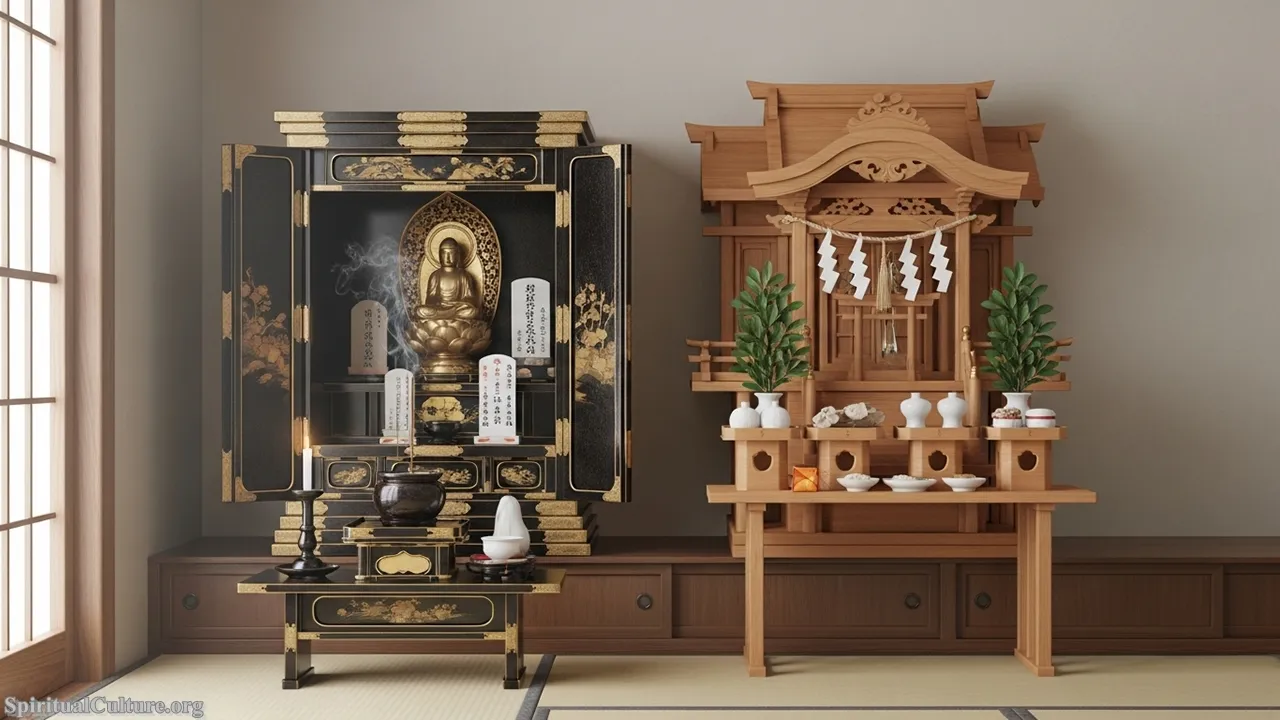
The spiritual impact is absolute, defining the entire lifecycle and cultural identity of the Japanese people. Citizens typically visit Shinto shrines for life events (birth, marriage, New Year) to seek blessings from the Kami and purify themselves, and rely on Buddhist temples for funerals, ancestor veneration (Hōji), and addressing the destiny of the soul. This unique syncretism underpins nearly every other cultural tradition—Matsuri are Shinto-centric, while Tea Ceremony and Bushi-dō draw heavily on Zen Buddhism—making it the essential spiritual operating system of the nation.
Even as global trends promote secularism, the cultural practice of dual adherence remains robust, validating the deep, practical utility of this spiritual framework. The tradition teaches the vital moral lesson of complementation: that life is a dynamic whole where the sacred and the mundane, the local and the universal, and joy and sorrow are not opposing forces but two inseparable aspects of a complete human existence.
Cultural/Spiritual Highlights
- Shinbutsu-shūgō is the historical blending of Shinto and Buddhism, defining Japanese spirituality.
- Shinto focuses on Kami (gods/spirits) in nature; Buddhism focuses on the ancestral world.
- Nearly all major life rites (except funerals) are Shinto-led; funerals are predominantly Buddhist.
- The practice of keeping a Butsudan (Buddhist altar) and a Kamidana (Shinto shelf) in the same home is common.
Conclusion
The cultural traditions of Japan, from the spiritual precision of Chadō to the communal passion of Matsuri, form an extraordinary tapestry that celebrates beauty, mindfulness, and the profound harmony between humanity and the natural world. These Top 10 traditions, anchored by the foundational synthesis of Shinto and Buddhist Rites, prove that a nation can embrace the future while remaining deeply rooted in the wisdom of its past. As of the Current Time of Writing, this heritage is more than just history; it is a living, breathing guide for a life of purpose, discipline, and profound aesthetic appreciation. Spiritual Culture celebrates these “Ways” (dō) as a timeless gift, demonstrating how ritual and art can lead to a deeper understanding of the self and the cosmos.




